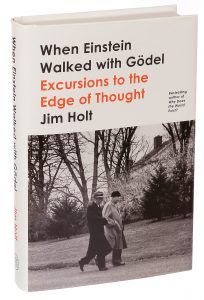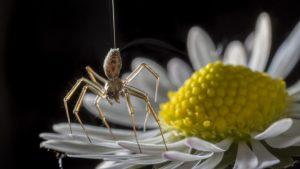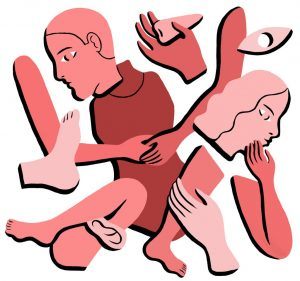Jennifer Summit and Blakey Vermeule in the Chronicle of Higher Education:
 When we were teaching at Stanford in the late 2000s, the terms “techie” and “fuzzy” became cultural touchstones: The “techies” majored in engineering and the sciences, the “fuzzies” in arts and the humanities. Faculty and administrators deplored those words, and students furiously debated them, but the terms — and the split they describe — have become an unshakable stereotype.
When we were teaching at Stanford in the late 2000s, the terms “techie” and “fuzzy” became cultural touchstones: The “techies” majored in engineering and the sciences, the “fuzzies” in arts and the humanities. Faculty and administrators deplored those words, and students furiously debated them, but the terms — and the split they describe — have become an unshakable stereotype.
Of course, polarization between the humanities and the sciences is by no means unique to Stanford. We hear it when politicians challenge public universities to justify spending on departments outside STEM fields; we hear it when humanities scholars counter that the value of their fields transcends practical application. Defenders of the humanities insist that they teach foundational values and skills; their detractors taunt them for offering “worthless” degrees.
The terms of the debate have become so familiar that speakers on both sides, however vehement or heartfelt their arguments, appear to be reading from a well-worn script. So ingrained is this conflict that it is easy to believe it describes a fundamental division in human knowledge. Although we are literary scholars, we are not here to defend the humanities against the sciences, but instead to show how an age-old debate has both created the division and can show the way past it.
More here.

 For scientists, pain has long presented an intractable problem: it is a physiological process, just like breathing or digestion, and yet it is inherently, stubbornly subjective—only you feel your pain. It is also a notoriously hard experience to convey accurately to others. Virginia Woolf bemoaned the fact that “the merest schoolgirl, when she falls in love, has Shakespeare or Keats to speak her mind for her; but let a sufferer try to describe a pain in his head to a doctor and language at once runs dry.” Elaine Scarry, in the 1985 book “The Body in Pain,” wrote, “Physical pain does not simply resist language but actively destroys it.”
For scientists, pain has long presented an intractable problem: it is a physiological process, just like breathing or digestion, and yet it is inherently, stubbornly subjective—only you feel your pain. It is also a notoriously hard experience to convey accurately to others. Virginia Woolf bemoaned the fact that “the merest schoolgirl, when she falls in love, has Shakespeare or Keats to speak her mind for her; but let a sufferer try to describe a pain in his head to a doctor and language at once runs dry.” Elaine Scarry, in the 1985 book “The Body in Pain,” wrote, “Physical pain does not simply resist language but actively destroys it.” “My ideal is the cocktail-party chat,” [Jim Holt] writes in the preface to his new essay collection, “When Einstein Walked with Gödel,” “getting across a profound idea in a brisk and amusing way to an interested friend by stripping it down to its essence (perhaps with a few swift pencil strokes on a napkin). The goal is to enlighten the newcomer while providing a novel twist that will please the expert. And never to bore.”
“My ideal is the cocktail-party chat,” [Jim Holt] writes in the preface to his new essay collection, “When Einstein Walked with Gödel,” “getting across a profound idea in a brisk and amusing way to an interested friend by stripping it down to its essence (perhaps with a few swift pencil strokes on a napkin). The goal is to enlighten the newcomer while providing a novel twist that will please the expert. And never to bore.”
 In 1997, when Dani Rodrik, a Turkish-born professor at Harvard’s Kennedy School of Government, published his brief book Has Globalization Gone Too Far?, progressive economists widely embraced his arguments that many free trade policies adopted by the US, which reduced tariffs and other protections, also weakened the bargaining power of American workers, destabilized their wages, and encouraged social conflict. “The danger,” Rodrik wrote presciently, “is that the domestic consensus in favor of open markets will ultimately erode to the point where a generalized resurgence of protectionism becomes a serious possibility.” I remember that Robert Kuttner, the coeditor of The American Prospect, was particularly enthusiastic about the book. Almost twenty years later, he again praised Rodrik for his continued devotion to an empirically grounded skepticism of what Rodrik now calls “hyperglobalization.”
In 1997, when Dani Rodrik, a Turkish-born professor at Harvard’s Kennedy School of Government, published his brief book Has Globalization Gone Too Far?, progressive economists widely embraced his arguments that many free trade policies adopted by the US, which reduced tariffs and other protections, also weakened the bargaining power of American workers, destabilized their wages, and encouraged social conflict. “The danger,” Rodrik wrote presciently, “is that the domestic consensus in favor of open markets will ultimately erode to the point where a generalized resurgence of protectionism becomes a serious possibility.” I remember that Robert Kuttner, the coeditor of The American Prospect, was particularly enthusiastic about the book. Almost twenty years later, he again praised Rodrik for his continued devotion to an empirically grounded skepticism of what Rodrik now calls “hyperglobalization.” Novelist, poet, and essayist
Novelist, poet, and essayist  Some nightmares, the worst ones, move so slowly that you don’t wake up from them right away. The terror feels normal, even though you may know something’s not right. It’s a usual sort of bad feeling, typical enough to fool the mind into believing that you may be awake. That is, until the monster shows up. Only then does the brain recognize it is inside something that isn’t real. “Sharp Objects,” HBO’s latest limited series from “Dietland” creator Marti Noxon and Jean-Marc Vallée, and based on a novel by Gillian Flynn (“Gone Girl”), reproduces that sensation throughout the seven of its eight episodes that were provided for review.
Some nightmares, the worst ones, move so slowly that you don’t wake up from them right away. The terror feels normal, even though you may know something’s not right. It’s a usual sort of bad feeling, typical enough to fool the mind into believing that you may be awake. That is, until the monster shows up. Only then does the brain recognize it is inside something that isn’t real. “Sharp Objects,” HBO’s latest limited series from “Dietland” creator Marti Noxon and Jean-Marc Vallée, and based on a novel by Gillian Flynn (“Gone Girl”), reproduces that sensation throughout the seven of its eight episodes that were provided for review. ON JUNE
ON JUNE  In spite of the obsession with Soros, there has been surprisingly little interest in what he actually thinks. Yet unlike most of the members of the billionaire class, who speak in platitudes and remain withdrawn from serious engagement with civic life, Soros is an intellectual. And the person who emerges from his books and many articles is not an out-of-touch plutocrat, but a provocative and consistent thinker committed to pushing the world in a cosmopolitan direction in which racism, income inequality, American empire, and the alienations of contemporary capitalism would be things of the past. He is extremely perceptive about the limits of markets and US power in both domestic and international contexts. He is, in short, among the best the meritocracy has produced.
In spite of the obsession with Soros, there has been surprisingly little interest in what he actually thinks. Yet unlike most of the members of the billionaire class, who speak in platitudes and remain withdrawn from serious engagement with civic life, Soros is an intellectual. And the person who emerges from his books and many articles is not an out-of-touch plutocrat, but a provocative and consistent thinker committed to pushing the world in a cosmopolitan direction in which racism, income inequality, American empire, and the alienations of contemporary capitalism would be things of the past. He is extremely perceptive about the limits of markets and US power in both domestic and international contexts. He is, in short, among the best the meritocracy has produced. Spiders have no wings, but they can take to the air nonetheless. They’ll climb to an exposed point, raise their abdomens to the sky, extrude strands of silk, and float away. This behavior is called ballooning. It might carry spiders away from predators and competitors, or toward new lands with abundant resources. But whatever the reason for it, it’s clearly an effective means of travel. Spiders have been found two-and-a-half miles up in the air, and 1,000 miles out to sea.
Spiders have no wings, but they can take to the air nonetheless. They’ll climb to an exposed point, raise their abdomens to the sky, extrude strands of silk, and float away. This behavior is called ballooning. It might carry spiders away from predators and competitors, or toward new lands with abundant resources. But whatever the reason for it, it’s clearly an effective means of travel. Spiders have been found two-and-a-half miles up in the air, and 1,000 miles out to sea. The starkest example of the many racist and anti-poor measures directed at African Americans and passed during his administration was the 1996 welfare reform bill, which transformed welfare from an exclusive and unequal cash assistance system that stigmatized its recipients into one that actually criminalized them.
The starkest example of the many racist and anti-poor measures directed at African Americans and passed during his administration was the 1996 welfare reform bill, which transformed welfare from an exclusive and unequal cash assistance system that stigmatized its recipients into one that actually criminalized them. Emtithal Mahmoud was brimming with rage and misery when she sat down to write her poem Mama. Her grandmother had just died in
Emtithal Mahmoud was brimming with rage and misery when she sat down to write her poem Mama. Her grandmother had just died in  In the 12 wide-ranging stories of her latest collection, “Days of Awe,” A. M. Homes skillfully circles and tugs at the question of what it means to live in flawed, fragile, hungry human bodies. One character embeds rose thorns in her feet; several have very disordered eating habits; people die too young, go to war and hold in their cells and minds the memories of past trauma. The title story is about a war reporter and a novelist who meet at a conference on genocide and have a weekend affair. Here the body is death — the millions killed who haunt the conference attendees — but it’s also desire. The affair is vivid and real and yet there is a shard of violence in it, the everyday violence of two people using each other to counter pain they don’t know how to digest.
In the 12 wide-ranging stories of her latest collection, “Days of Awe,” A. M. Homes skillfully circles and tugs at the question of what it means to live in flawed, fragile, hungry human bodies. One character embeds rose thorns in her feet; several have very disordered eating habits; people die too young, go to war and hold in their cells and minds the memories of past trauma. The title story is about a war reporter and a novelist who meet at a conference on genocide and have a weekend affair. Here the body is death — the millions killed who haunt the conference attendees — but it’s also desire. The affair is vivid and real and yet there is a shard of violence in it, the everyday violence of two people using each other to counter pain they don’t know how to digest. At the age of 39 I was fairly sure I would spend the rest of my life alone. I lived alone, I worked alone. No matter what I did, or who I dated, I didn’t seem to be able to find the relationship I longed for.
At the age of 39 I was fairly sure I would spend the rest of my life alone. I lived alone, I worked alone. No matter what I did, or who I dated, I didn’t seem to be able to find the relationship I longed for. If the ICS [International Commission on Stratigraphy] declares the Anthropocene as a new epoch, it will reverse at one stroke three great humiliations science has inflicted on humanity. First, it will restore humanity to the self-importance it knew when people believed that the Earth and humanity were created at about the same time. The Anthropocene, as Erle Ellis and colleagues have written, “will divide Earth’s story into two parts: one in which humans are a geological superpower — an epoch called the Anthropocene — and the other encompassing all that came before our species had a major influence on Earth’s functioning.”
If the ICS [International Commission on Stratigraphy] declares the Anthropocene as a new epoch, it will reverse at one stroke three great humiliations science has inflicted on humanity. First, it will restore humanity to the self-importance it knew when people believed that the Earth and humanity were created at about the same time. The Anthropocene, as Erle Ellis and colleagues have written, “will divide Earth’s story into two parts: one in which humans are a geological superpower — an epoch called the Anthropocene — and the other encompassing all that came before our species had a major influence on Earth’s functioning.” “Democracies erode slowly, in barely visible steps” these days, Steven Levitsky and Daniel Ziblatt write in
“Democracies erode slowly, in barely visible steps” these days, Steven Levitsky and Daniel Ziblatt write in